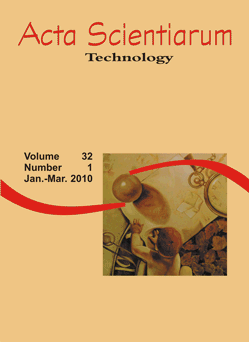<b>Lipase production by bacterial isolates from petroleum contaminated soil</b> - DOI: 10.4025/actascitechnol.v32i1.7550
DOI:
https://doi.org/10.4025/actascitechnol.v32i1.7550Keywords:
submerged fermentation, lipolytic activities, inducerAbstract
Lipase production by bacterial isolates from petroleum contaminated soil. This paper aims to present alternatives to the production of lipolytic enzymes from microorganisms isolated from soil with a history of contact with oil from the region of Sergipe, by submerged fermentation using palm oil as inducer. The experiments were conduced in 250 mL Erlenmeyer flasks in a shaker (170 rpm), containing 125 mL (%, w v-1) of KH2PO4, MgSO4.7H2O, NaNO3, yeast extract, peptone and starch. The pH was 5.0 and 7.0; incubation temperature was 30 and 37°C, respectively; fermentation time was 24, 48, 72, 96h, 120 and 144h; and the inducer concentration was 3 and 4%, added after 72h of fermentation. The determination of lipolytic activity was examined at 37°C, in a shaker in thermostatic bath with rotation of 82 rpm, using gum arabic 7% (w v-1), olive oil and water. The reactions were conducted for 10 min with agitation and later stopped by the addition of an acetone:ethanol:water solution, where released fatty acids were titrated with a solution of KOH (0.04 N), using phenolphthalein as an indicator. The maximum activity was determined as 4369.75 U mL-1 pH 7.0 and a temperature of 37°C, with the percentage of the inducer oil palm to 4%.Downloads
Download data is not yet available.
Downloads
Published
2009-11-13
How to Cite
Feitosa, I. C., Barbosa, J. M. de P., Orellana, S. C., Lima, Ílvaro S., & Soares, C. M. F. (2009). <b>Lipase production by bacterial isolates from petroleum contaminated soil</b> - DOI: 10.4025/actascitechnol.v32i1.7550. Acta Scientiarum. Technology, 32(1), 27–31. https://doi.org/10.4025/actascitechnol.v32i1.7550
Issue
Section
Biotechnology
License
DECLARATION OF ORIGINALITY AND COPYRIGHTS
I Declare that current article is original and has not been submitted for publication, in part or in whole, to any other national or international journal.
The copyrights belong exclusively to the authors. Published content is licensed under Creative Commons Attribution 4.0 (CC BY 4.0) guidelines, which allows sharing (copy and distribution of the material in any medium or format) and adaptation (remix, transform, and build upon the material) for any purpose, even commercially, under the terms of attribution.
Read this link for further information on how to use CC BY 4.0 properly.











8.png)




